Alsym Green: the highest performing non-lithium battery
Alsym Green is the highest-performing non-lithium battery for stationary storage. It offers energy density that is 2x to 10x higher than competing technologies, stores up to 1.7 MWh of energy in a 20′ BESS container, provides fast charge (4 hours) and flexible discharge (2 to 110 hours), and has 92% round-trip efficiency. Its non-toxic, non-flammable design, combined with low self-discharge (<0.25% per day) and industry-leading LCOS, makes it the ideal choice for stationary energy storage.
High energy density, small footprint
Lithium-ion batteries provide high energy density in small footprints, but are unsuitable for most large-scale and/or concentrated use cases due to the risk of fires and highly toxic gas emissions. Lithium-ion BESS integrators continue to pack as much energy into a standard 20′ container as possible, but as energy density increases so does the risk of fires and explosions in those systems.
Safer non-lithium technologies are available, but these have low energy densities, large physical footprints and other performance problems (RTE below 50%, etc.) that limit them to very specific use cases. These factors make them impractical in cities and other areas where land is expensive (assuming it’s even available). Large low-density battery installations can potentially be sited in rural areas where land costs are lower but this requires building new transmission capability, which is also prohibitively expensive. And in some cases, grid interconnection fees can be high enough to make new storage projects fiscally prohibitive.
Energy density is less important when it comes to stationary storage than it is for EVs, but it still matters for several reasons. A higher energy density allows more energy to be stored in a smaller volume, which is crucial for space-constrained installations, such as urban environments, commercial buildings, or residential areas. Higher energy density means fewer containers or fewer cells are required to store a given amount of energy. This reduces the overall cost of materials, shipping and handling, installation, and infrastructure. According to PNNL, non-battery costs can make up as much as 75% of total system costs. Optimizing the number of containers is critical to keeping costs low.

High operating efficiency
Combining high energy retention, high RTE, and long service life results in significant operational savings. Users can store and retrieve more energy efficiently, with fewer energy losses and reduced system wear over time. With round-trip efficiency (RTE) comparable to lithium-ion, systems with Alsym Green cost less to charge than other non-lithium options. It means you keep more of the energy you put into the system, and allows you to reduce the size of charging infrastructure. For example, a battery with 45% RTE may require a solar array twice the size of what’s required to charge a battery with 92% RTE.
Alsym Green’s low self-discharge rate (<0.25% per day) ensures that you don’t lose energy when the system isn’t being used. It helps to enahnce system reliability even if you haven’t charged your system for days (or weeks). It also reduces total system charging costs.
Alsym Green cycles effectively for more than 5,000 cycles for total service life up to 20 years (depending on cycling frequency). Unlike other chemistries, Alsym Green has a linear degradation curve with no sudden drop-off, allowing for predictable performance for more than 20,000 cycles to loss of function.
These factors contribute to a BESS that can operate efficiently over a long period, providing consistent, cost-effective energy storage. This is critical for long-term grid support, renewable energy integration, and efficient energy management.



Safe operation in high temperatures
Inherently non-flammable Alsym Green cells can operate effectively at high ambient temperatures, reducing the need for expensive cooling systems and leading to lower operational costs and energy savings. It also means less space has to be dedicated to auxiliary safety and firefighting systems, creating more room for battery cells. The wide temperature range makes Alsym Green cells ideal for outdoor or off-grid applications in hot climates, where the risk of overheating is a concern for other technologies.
For lithium-ion batteries, high temperatures can cause performance degradation or safety issues. If cells reach 60° C, protection systems are required to shut the system down as a preventative safety measure. At elevated temperatures, the organic solvents in lithium-ion electrolytes can decompose, releasing gases and increasing pressure inside the cell. This buildup can lead to cell rupture or violent release of energy. Once a lithium-ion cell reaches a critical temperature, exothermic chemical reactions within the cell accelerate, generating even more heat. This creates a feedback loop where the heat causes further reactions, rapidly raising the temperature and leading to catastrophic failure. In BESS systems, thermal runaway in one cell can spread to neighboring cells in the battery pack, causing a chain reaction that increases the risk of fires in large-scale installations.

